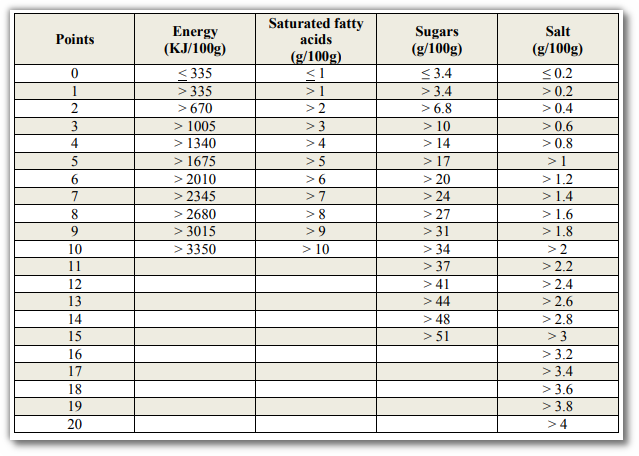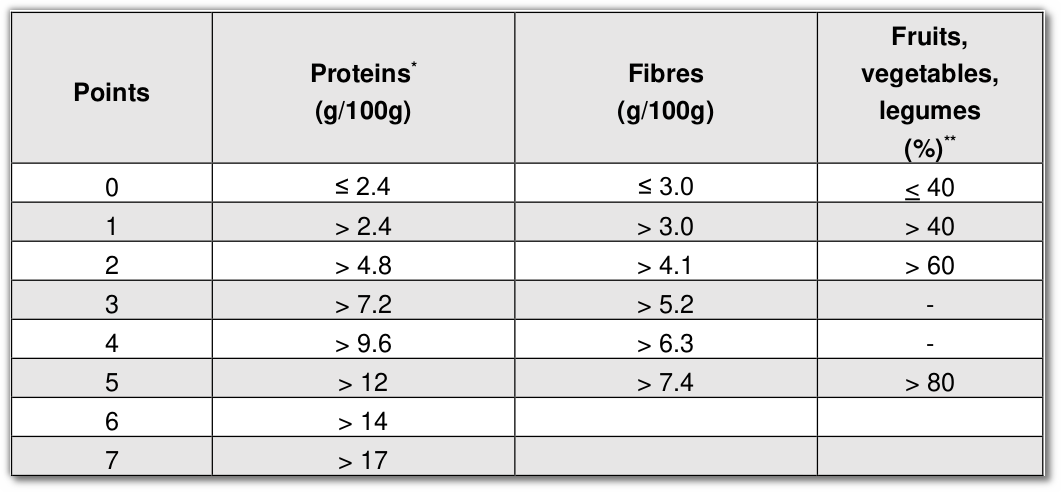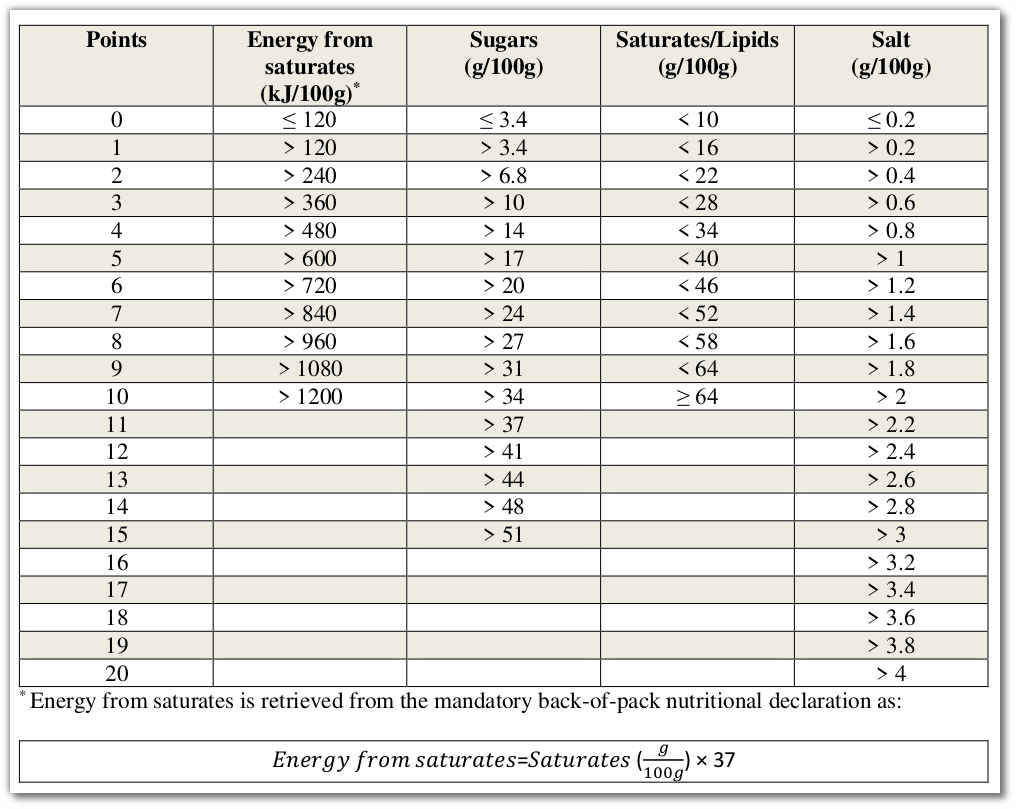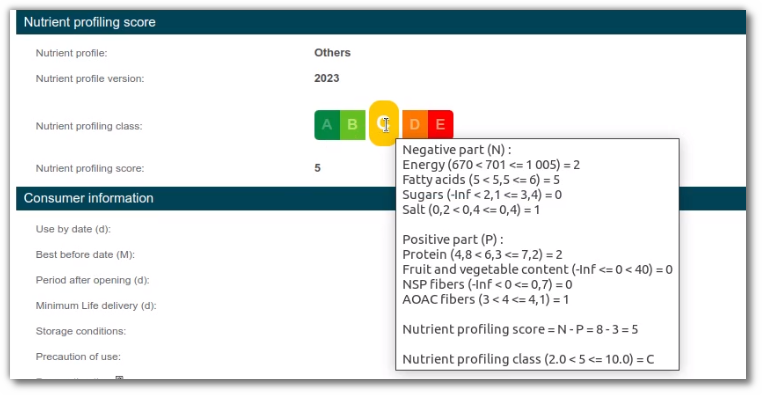Nutri-score
This section explains the nutriscore principle and how it is calculated on beCPG.
The Nutri-Score is a graphic scale that divides the nutritional score into 5 classes (expressed by a colour and a letter), the purpose being to help the consumer better see, interpret and understand the nutritional value.
The Nutri-Score has been adopted by different European countries (France, Belgium, Spain, Germany, the Netherlands, Luxembourg and Switzerland). The objective is not to separate 'good' foods from 'bad' foods, but rather to use the 5 classes to distinguish foods that are healthier from those that are less healthy from a nutritional point of view. This also helps food producers to decide how to reformulate their products so they can move to a higher score.

The different objectives and outcomes of the modifications are as follows :
- Improve the classification of fatty fish
- Improve the discrimination between whole grain products rich in fiber and refined products in alignment with food-based dietary guidelines
- Improve the discrimination between vegetable oils
- Improve the discrimination of products according to their sugar content, especially for products very rich in sugar, sweetened dairy products and sweetened breakfast cereals
- Improve the discrimination of products according to salt content 6
- Improve the discrimination between red meat – to be limited in food-based dietary guidelines – compared to poultry
- Improve the discrimination of beverages according to their sugar content, in particular for beverages with low contents in sugar
- Improve the discrimination of milk (skimmed/partially-skimmed milk and whole milk) according to their saturates and energy content, and the discrimination of milk-based beverages and fermented milkbased beverages according to their sugars content
- Allow an alignment of the classification for NNS-sweetened beverages with current recommendations not to promote their consumption.
The nutritional score is calculated using the data from the nutritional declaration per 100 g or 100 mL of product as sold (excepted specific cases) and from the ingredient list. Points are attributed according to the content in :
- unfavourable' elements : an excess of which is considered unhealthy: energy in KJ, sugars, salt and saturated fatty acids (and non-nutritive sweeteners for beverages for the 2023 calculation method);
- favourable' elements : protein, fibres, fruits, vegetables, legumes (and for the 2017 calculation method: nuts, and rapeseed, walnut and olive oils).
Nutriscore calculation method
Determination of the food category
The updated Nutri-Score algorithm includes three main categories of products:
- General foods
- Specific rule for Cheeses
- Specific rule for Red meat
- Animal and vegetable fats, nuts and seeds
- Beverages
Collect of the composition data
The computation of the Nutriscore takes into account the following data:
- Energy value ;
- % Fibers ;
- % Proteins ;
- % Salt ;
- % Sugar ;
- % Saturated fats ;
- (% Lipids in case of « Fats » category) ;
- Fruits and vegetables content here is the non-exhaustive list :
- Dried vegetables (lens, chickpeas, soyseeds…) ;
- Nuts (pistachio nuts, nuts including peanuts, cashew, coconut …) ;
- Herbs ;
- Oils (Rapeseed, walnut and olive oils).
- Sweeteners
However, fruits and vegetables don’t include :
- Seeds (poppy, sunflower, pine nuts, chia);
- Potatoes and other starchy tubers such as sweet potatoes.
- Dried vegetables and maize flours.
- Quinoa
- Spices
Moreover, to be integrated in the 5C computation, fruits and vegetables musn’t have undergone more than one minimal transformation process. Food considered as « Intacts » include cooked food, dried food, peeled food, sliced food, appertised food, frozen food, juices and purees.
For the dried or concentrated fruits and vegetables, a specific computation must be realised in order to obtain the total content of fruits and vegetables :
\[ (mass of fruits, vegetables, dried vegetables, nuts + (2 x mass of
fruits, vegetables, dried vegetables, dried nuts or concentrated
tomato)) / (mass of fruits, vegetables, dried vegetables, nuts + (2 x
mass of fruits, vegetables, dried vegetables, dried nuts or concentrated
tomato) + mass of ingredients excluding fruits, vegetables, dried
vegetables, nuts) \] x 100
For this calculation, fruits and vegetables can be taken into account before or after cooking but they have to be all considerated in the same state.
Computation of the negative part and positive part of the nutritional score or « a-score »
General Case
The nutritional score for food products relies on the calculation of a single, overall score which takes into account, for every food product:
- a “negative” component N
- a “positive” component P
The N component of the score takes into account nutritional elements which consumption should be limited : energy, saturated fatty acids, sugars, and salt. For each of these elements points from 0 to 20 are awarded based on the content for 100 g of food product. The negative N component corresponds to the sum of these points, and thus can range from 0 to 55.

The P component is calculated based on the amount of fibers, proteins, and fruits, vegetables, and legumes in the food product. For each of these elements, points from 0 to 7 are awarded based on the content for 100 g of food product. The positive P component corresponds to the sum of these points and thus can range from 0 to 17.
For red meat and products thereof, the number of points for proteins is limited to 2. The positive P component can therefore vary from 0 to 12 points.

Depending on the score obtained for the N component, the final nutritional score is calculated as follow:
If the total of component N is below 11 points or if the product is cheese, then the nutritional score is equal to the total N component points from which is subtracted from the total for the P component.
Nutritional score = total N points - total P points
If the total of the N component is greater than or equal to 11 points, then the nutritional score is equal to the total N component points from which is subtracted from the sum of the points for “fibres” account in the calculation of the nutritional score.
Nutritional score = total N points - “fibres” points - “Fruits, vegetables, legumes” points

Specific Case
Animal and vegetable fats, nuts and seeds:
Scores for animal and vegetable fats, nuts and seeds are calculated using the following point tables:

Energy from saturates = Saturates (g/100g) * 37
Points attributed to each of the elements of the positive P component in the specific case of animal and vegetable fats, nuts and seeds

Calculation of the nutritional score for animal and vegetable fats, nuts and seeds
Depending on the score obtained for the N component, the final nutritional score is calculated as follow:
If the total of component N is below 7 points, then the nutritional score is equal to the total N component points from which is subtracted the total for the P component.
Nutritional score = total N points - total P points
If the total of the N component is greater than or equal to 7 points, then the nutritional score is equal to the total N component points from which is subtracted the sum of the points for “fibres” and “Fruits, vegetables, legumes”. In this case, the protein content is therefore not taken into account in the calculation of the nutritional score.
Nutritional score = total N points – “fibres” points – “Fruits, vegetables, legumes” points
Beverages
Scores for beverages are calculated using the following point tables (see below). In this specific case, the negative N component also includes points for the presence of non-nutritive sweeteners:


Calculation of the nutritional score for beverages
The final calculation of the nutritional score is reached by subtracting the positive P component from the negative N component:
Nutritional score = total N points - total P points
Logo attribution
The Nutri-Score logo is attributed based on the nutritional score calculated (see table below) :

Determination of 5C score though beCPG software
How to add the nutrients required for the 5C score computation
The following nutrients:
- Salt (mg/100g);
- Energetic value (kJ/100g);
- Sugar(g/100g);
- saturated fatty acid (g/100g);
- AOAC fibers;
- Proteins (g/100g);
- Total lipids (g/100g);
Are automatically displayed in the "Nutrients" list of the product.
On the contrary:
- Fruits and vegetable content is a physicochemical characterstic (Code = FRUIT_VEGETABLE) which should be added if necessary in the corresponding list;
- NSP fibers is a nutrient which should be added if necessary in the corresponding list
- Sweeteners included in the drinks category are present in the list of ingredients. The sweeteners taken into account in the drinks category are present in the list of ingredients. Below is the list of additives taken into account. The codes must be set up correctly in the administration system for the calculation to work correctly.

Determination of the food category
In order to compute the 5C score of your product, go to your product and in « Properties » ➔ « Edit properties ». In « Nutrient profiling score » section choose the category of you product. We are still to choose the old version of Nutriscore.

If the section doesn’t appear, go to « Properties » and press « Add an aspect » in order to choose « Nutrient score profile».

Presentation of the final score on beCPG
Properties
Once you have saved your properties. The score appears in the properties and by moving the mouse over the logo, you can access the calculation details.

Nutrients
You can also consult the Nutrients list. Just like in the properties, by passing the mouse over the logo, you can access the calculation details.

Composition
You can also add dynamic characteristics to the Composition list, with the formula.
Here is the formula with the logo and the corresponding letter:
"@html"+nutrientClass+"</span>"

Here is the formula for the nutriscore details and the corresponding letter:
var context =T(fr.becpg.repo.product.formulation.score.NutriScoreContext).parse(nutrientDetails);#context.toHtmlDisplayValue();

N.B.
- For fibers, there are two scales corresponding to each analysis
method:
* NSP method : doesn’t measure out lignin and resistant starch (without precision on the acquisition method) ; * AOAC method : measures out fractions, more or less important of the resistant starch (content obtained from the AOAC method).
Source Sante publique 2023, https://www.santepubliquefrance.fr/media/files/02-determinants-de-sante/nutrition-et-activite-physique/nutri-score/q-a-en